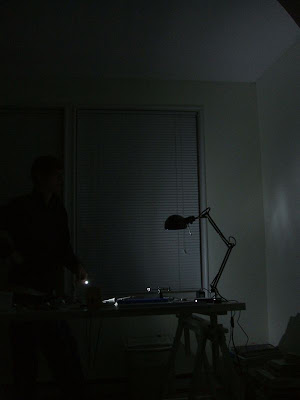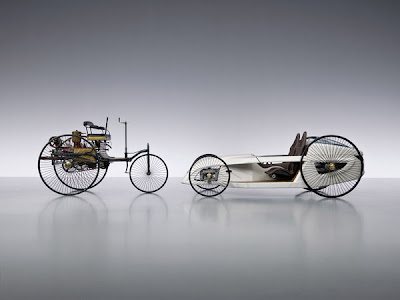All right, so I have wired up a sweet set of lights for all purpose triking needs. We wanted a good high-powered set of LED lights, but there are problems with premade lights:
-They are too dim
-Alternately, they are bright but very expensive, and
-They universally look boring
We found a cool set of art-deco style bullet lights at
BikeWorld USA in both clear and red:
-Clear bullet lights-Red bullet lights-Large red bullet light with finsThese are the perfect art-deco style light, but the problem is they have crappy low-powered light bulbs. The solution then was to buy the bullet lights, but remove the light bulbs and add our own high-powered LEDs. Thus there are 2 parts to this project, swapping the lamps for LEDs, and creating support electronics for the lamps. At this point in time only the tail-lights are finished, so I am going to detail the build of the tail lights.
Parts List:(Relevant data sheets are linked)
So, let me start off at the lamps themselves. The lamps needed to have the light bulbs removed, and the LEDs mounted. I also decided that the lamps needed sealing, as they did not come with any sort of seal where the wire enters.
So let's start with a bullet light:

This is the bullet light disassembled, with the light bulb and wiring removed:

I soldered wires onto the leads of the LED and ran the wires into the lamp:

I then used a dab of epoxy to seal the back of the lamp, where the wires stick out. The epoxy was left to dry for 24 hours.
I repeated this process for the second red bullet light.
Now let's look at the red bullet light with fins:

Internals removed, LED added:

As before, where the wires exit the lamp was sealed with epoxy and left to dry.
For both types of lamp, the epoxy was plenty strong enough to hold the LEDs in place, so no additional mounting was necessary.
Now, I needed support electronics to actually power the LEDs. I wanted the electronics to be usable with both battery (DC) power and generator (AC) power, which is the reason for the bridge rectifier and voltage regulator.
The circuit is shown below:

The schematic above includes the white LEDs, which I will cover in a future post. The battery in the schematic can be replaced with a bike generator, as long as it is at least 7 volts. 12 volts is a common bike generator output, which would work for this build. I plan on eventually adding a switch so that the lights can be flipped between generator and battery power, but that is not in this current build.
I don't have a PCB layout for this circuit as that was a bit beyond the scope of the project and I lack access to PCB etching equipment. I fit all the parts onto a two inch by two inch circuit board. I added a heatsink to the voltage regulator, I'm not actually sure how necessary it is but I had some heat sinks sitting in my parts box and it seemed like a good precaution. The resistors in this circuit are going to be sinking a fair amount of power, so don't use puny 1/4 watt resistors. I used 3 watt resistors for the red LEDs.
The finished circuit is shown below. I labelled parts for your reference.

The circuit board and batteries will be going in the metal weatherproof project box.

I epoxied fabric down where the circuit board will sit in order to prevent short circuits.

I also mounted the power switch by drilling a hole (1/4 inch) and bolting the switch down.

I also put fabric on the bottom of the battery holders, because they had exposed contacts, and I didn't want them rubbing against the metal project box and shorting out.

Finally, I crammed the whole thing into the box. The box now holds the circuit board and two battery holders which each hold 4 rechargeable AA batteries. I also used the same 1/4 inch drill bit to drill a pair of holes, one for the black ground wires and one for the red +5v wires. I will be running 3 taillights with this box (and eventually 3 headlights as well).

And finally, with the cover added:


Now, the lamps are as-of-yet not mounted on the trike, but I wanted to preview their brightness, so here are a couple of pictures with the lit lamps.



And there you have it! In future posts I will cover the headlights as well as the mounting of the lights onto the trike itself. Take care!
-Alan





















































